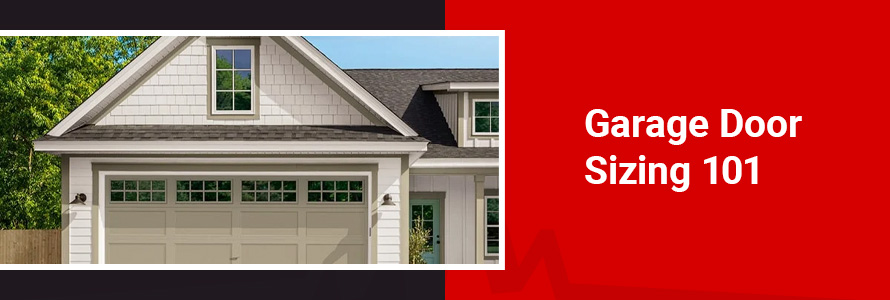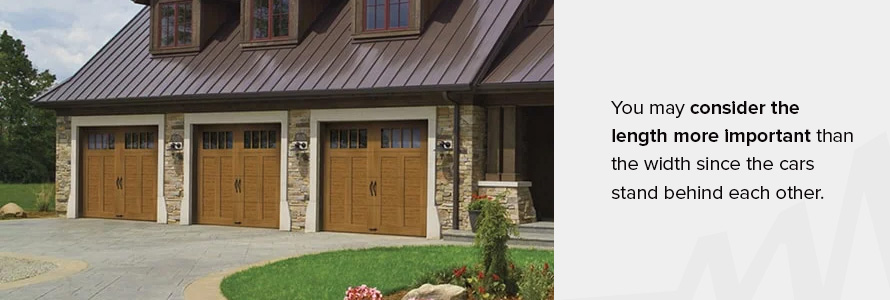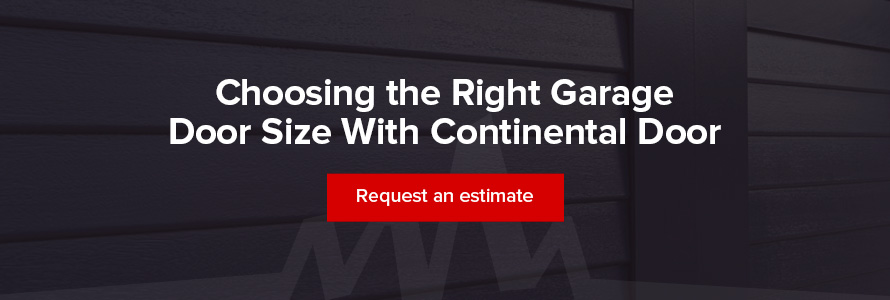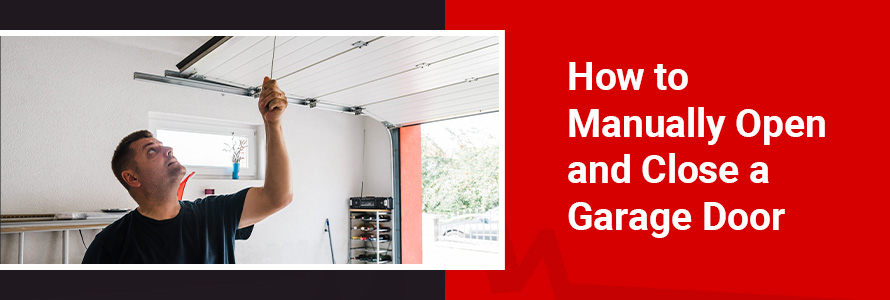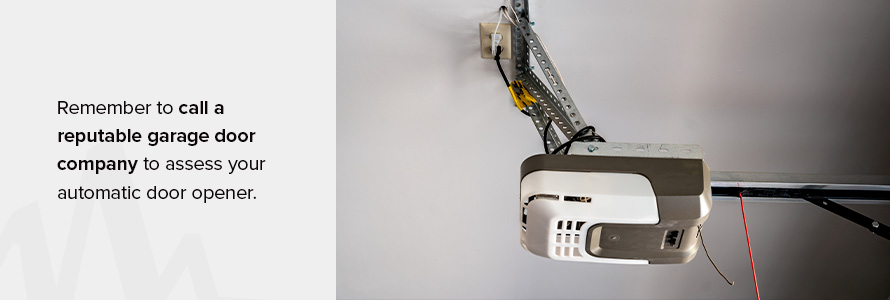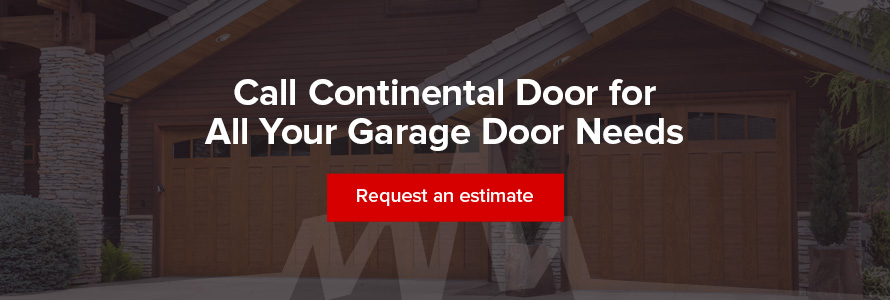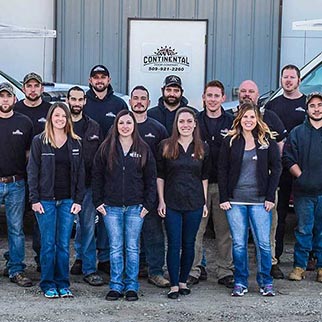Garage Door Sizing 101
Common Garage Door Sizing
Getting the right garage door size is essential when installing a new garage door at home. The number of cars your garage holds determines the size, but the measurements must be accurate to ensure a door that fits.
Explore the standard garage door sizes for various sized garages, including smaller and custom garage doors.
Understanding Garage Door Sizes for Your Home or Project
Whether you’re building a new garage or expanding your current one, the garage space comprises different dimensions that must be calculated individually and holistically to get the right door measurements. A tape measure is sufficient to calculate all the dimensions within the garage. These are the main areas to consider:
- Garage door opening: The opening or entrance to the garage is the size of the garage door, allowing the car to pass through. The door opening height and width are measured in inches.
- Side room: This is the space between the walls and garage door openings on both sides. Torsion springs are usually fitted in this space and should ideally be 3.75 inches on each side.
- Headroom: This is the area between the ceiling and the top of the door opening. Include the garage door opener clearance, usually about 3 inches.
- Backroom: This is the depth of the garage or the length between the opening and the back wall.
- Floor: This is the ground space between the four garage walls measured in length and width or square footage.
Overview of Standard Garage Door Sizes
Garage door sizes vary according to home sizes, but most are standard unless there are custom requirements.
The car sizes impact the dimensions as some homeowners may build according to the vehicle types. For example, they may have a hatchback, a Jeep or SUV, and an RV they want to park in one garage. Standard double garage door dimensions may not be suitable in this case.
The common dimensions for one- to four-car garages are measured in width by depth in feet, while other uncommon dimensions are included in the following section.
- Single garages: These hold one car and are typically available in 8-by-7 feet, 8-by-8 feet, 9-by-7 feet or 9-by-8 feet. Another popular dimension is 12 -by-20 feet to accommodate a bigger vehicle and have enough space to walk around it in the garage and open the doors without touching the walls.
- Double garages: These fit two cars and come in standard sizes of 16 feet by 7 or 8 feet.
- Three-car garages: To fit three cars in a garage, you need approximately 30-by-20 feet up to 36-by-feet of space.
- Four-car garages: Housing up to four cars, this garage size is at least 40-by-20 feet up to 45-by-24 feet.
Detailed Dimensions for Various Garage Types
Regarding garage sizes, there are standard measurements, but the reality is that everyone’s needs differ. It’s not always a one-size-fits-all scenario. We explore the detailed dimensions for different garage types and what might best suit your requirements.
One-Car Garage Dimensions and Square Footage: Essential for Small Households
The dimensions for one-car garages are usually based on the home size. Households with only one vehicle don’t need much space but still need to avoid making the garage too small. Some smaller homes might have limited storage space, and a larger garage can help solve this problem.
In general, one-car garage dimensions include:
- Width: 12-18 feet
- Depth: 20-30 feet
- Additional sizes: 12-by-25 feet, 12-by-30 feet, 18-by-25 feet and 18-by-30 feet.
- Garage door width: 9-12 feet
- Area in square feet: 240-540 square feet
For more storage space, you could add half a car’s size in width, making the garage 18 feet wide instead of 12 feet. A 1.5-car garage provides ample space for a minivan or SUV in a single garage.
Two-Car Garage Dimensions and Square Footage: Ideal for Growing Families
Having multiple cars is common for growing families, so it’s important to accommodate an appropriate-sized garage. On average, double garages fit two cars and are measured as follows:
- Width: 22-30 feet
- Depth: 24-30 feet
- Additional sizes: 20-by-30 feet, 24-by-25 feet and 24-by-30 feet
- Garage door width: One 16-foot or 18-foot wide door, or two 9- to 12-foot wide doors
- Area in square feet: 360-660 square feet
The deeper or longer the garage, the more space you’ll enjoy. Consider adding 3-5 inches, depending on your vehicles’ sizes. You may want to have enough space for 2.5 cars, so you have extra room for storage or a workbench.
Three-Car Garage Dimensions and Square Footage: Balancing Space and Functionality
When you’re parking three cars, there are ways to balance space and functionality. Here, you may consider the length more important than the width since the cars stand behind each other. If parked next to each other to save space in length, one single garage and a double garage make sense.
Or, you could incorporate a four-car garage and use the additional space for storing smaller vehicles like a motorcycle or convert it into a workshop area.
How many square feet is a three-car garage? Standard dimensions for a single and double garage layout are typically these below:
- Width: 32-22 feet
- Depth: 20-30 feet
- Additional sizes: 36-by-24 feet
- Garage door width: An 8- to 10-foot-wide door and a 16- or 18-foot-wide door
- Area in square feet: 600-1,260 square feet
Detached three-car garages are another option if you don’t have space for an attached garage. Common dimensions for these include 32 x 24, 34 x 24 and 36 x 28.
Four-Car Garage Dimensions and Square Footage: A Multifunctional Space
Four-car garages require the most space in length and width and are versatile. So, how big is a four-car garage? These are the standard measurements:
- Width: 40-48 feet
- Depth: 20 feet or more
- Additional sizes: 24-by-45 feet
- Garage door width: Four 9- to 12-foot wide doors or two 16- to 18-foot wide doors
- Area in square feet: 800-1,680 square feet
Homeowners with four-car garages commonly use the extra space as a workshop, gym or recreational area.
Exploring Uncommon Garage Door Sizes
While most garages use standard garage door sizes, sometimes garages are built according to specific dimensions. Half sizes like 1.5- or 2.5-car garages can allow for more storage or workshop space, and five-car garages hold all your vehicles and projects.
With these, you’d add half a car’s width or more to standard sizes to achieve the ideal size.
Factors Influencing Garage Door Size Selection
Some factors that may influence the garage door size include:
- Garage type: The two main garage types are attached and detached from your home.
- Storage requirements: If you store hobby items and other goods alongside the parked cars, you’ll need a larger garage, which could mean a bigger door.
- Vehicle size: Ensure your garage is deep and wide enough to accommodate your varying vehicle sizes.
- Number of vehicles: Account for all your vehicles, including smaller, light vehicles like bicycles, motorbikes and scooters.
- Additional functionality: You may want to convert a section of a larger garage into a recreational or work area if you use a larger garage to park only one or two cars.
Maximizing Your Garage’s Potential
The above factors contribute to maximizing your garage’s potential as you consider space and customization options.
Utilizing Space Efficiently in Larger Garages
Larger garages allow numerous opportunities for utilizing space effectively. Whether you have a one-car or a four-car garage, you can use it for storage or as a recreational or work space.
Consider the garage layout and which parts are free. Corners and the far end are usually available to put up storage units or stack boxes. If there’s enough space, a table and chairs can create a lounge area.
Custom Garage Door Sizes: Tailoring to Your Needs
When planning a custom garage door, explore the options until you’re satisfied with what you can get. Value for money without compromising quality is key when considering the best local garage door companies.
A reputable contractor will advise you on customization preferences, like what can and can’t be customized. Explore their selections and what they can do for you.
Choosing the Right Garage Door Size With Continental Door
Continental Door’s expert team is always available to help our valued customers in Spokane and the surrounding areas. We have been driving customer satisfaction since 2000 and strive to deliver the best service.
If you’re interested in installing a new garage or upgrading your current one and need help determining the right garage door sizes, call us or request a free estimate today. We are always eager to help!
How to Manually Open and Close a Garage Door
How to Manually Close and Open Your Garage Door
In the past, manually opening and closing a garage door was common practice. Drivers had to get out, unlock the garage door, lift it, drive in, park and close the door behind them. These days, most garage doors are automatically operated, so the driver can easily open and close the door by remote control.
We may not need it often, but knowing how to manually open and close a garage door is important when necessary. Here’s how to open your garage door manually when there’s a reason it won’t open automatically.
Can You Manually Open and Close a Garage Door?
What happens if the power goes out? How do you open a garage door without power? What if you lose the remote? What if your garage door opener is broken? Do you know how to open a garage door without the remote? There are several reasons you should know how to open an electric garage door manually. If you can’t open the garage door manually when needed, read on to learn more.
Safety Precautions Before Manual Operation
Safety should always be your priority when handling a heavy garage door. Numerous moving components can pose a risk, including:
- Faulty or broken springs
- A door knocked out of its tracks
- Loose or snapped cables
Inspecting these parts regularly for wear and tear can help you identify and prevent issues later.
Forcing the door closed when the springs are broken can cause it to slam down forcefully. This can damage the door or harm anyone standing close. This is why it’s important to know why the door isn’t working automatically before attempting to operate it manually.
A professional garage door technician will identify the problem beforehand to ensure no issues could lead to damage or harm.
Preparing Your Garage Door for Manual Operation
Before handling your garage door manually, check that the springs, tracks, rails and cables are in working condition. The door should balance evenly and lift without too much resistance. Be careful when handling the door, as it can be surprisingly heavy, especially wooden doors. Aluminum and steel doors are lighter to handle.
Double-check to see whether the source of the problem is a power outage, and inspect the garage door remote control for dead batteries.
How to Open a Garage Door Manually
Opening the garage door manually is not too difficult. When you find yourself in a situation where technology fails you, manual operation is your only option. A power outage is usually the cause of your opener failing, but the opener could also be faulty. How to open an electric garage door manually depends on whether you’re trying to get in or out.
Opening the Door From the Inside
When you’re stuck inside and need to be somewhere, the last thing you want to deal with is an unresponsive garage door. Follow these steps to open it manually from the inside:
- Disengage manual locks or deadbolts.
- Turn off the garage door opener power source if it’s not already off.
- Find and pull the red hanging emergency release cord from the center track, disengaging the door from the garage opener.
- Lift the door by pulling it upwards from the center over your head, where it will slide onto the track and remain firmly in place.
- Pull out your car and lower the door manually again.
- Engage manual locks or deadbolts to secure the door.
Opening the Door From the Outside
If you’ve come home and can’t access your garage, you can also open the door manually to get inside. Here’s what to do:
- Find the emergency built-in release with a key slot at the top of your garage door.
- Enter and turn the key, then pull the lock mechanism outward.
- The emergency release cord should be disengaged.
- Pull the cord, disconnecting the motor.
- Unlock the garage door at the bottom next to the door handle.
- Lift the door from the bottom up over your head into the tracks until it’s in place.
Not all doors have this built-in release mechanism. If yours doesn’t, you’ll need a wire coat hanger and a ladder. Follow these alternative steps:
- Straighten the hanger wire and make a hook at one end.
- Slide the hooked end between the garage door and frame at the top center.
- Locate the emergency release lever and pull it with the hooked wire end.
- You’ll hear a click when the door is disengaged.
- Remove the wire and lift the door from the bottom upwards into the tracks until it slides into position.
- Enter the garage and manually pull it down to close it once parked.
For safety, pull the emergency release handle when the garage door is down. Be careful where you place your hands, as there are pinch points where sections come together. Remember to call a reputable garage door company to assess your automatic door opener.
Troubleshooting Tips for Opening Issues
Some common garage door opening issues and solutions include:
- An aged opener: If it is old and worn, it may be time to replace it.
- Broken springs or cables: If the springs or cables are broken, they can’t lift the door and must be replaced.
- Remote control issues: Check the battery to see if it’s still working, and replace it with a new battery if necessary.
- Blocked photo eye sensors: Dust and dirt can block their transmission. Clean the lenses on both to resolve the issue.
- Rusted rollers and tracks: Old, rusty ones can affect the door’s motion and should be lubricated regularly or replaced.
- Strange noises when opening: This may indicate an underlying issue like loose cables, roller, nuts and bolts, broken springs, or misalignment. It’s best to have a professional technician check your door.
How to Close a Garage Door Manually
Closing a garage door manually is simple. Here are the steps to follow.
- While the door is open and securely in place, pull the red emergency cord down and back towards the opener.
- You’ll hear a click when the door is disengaged from the opener.
- Hold the door in the center and guide it until it closes.
- Secure it by locking the door at the bottom.
Returning Your Garage Door to Automatic Mode
Now that you know how to open and close an automatic garage door manually, you should know how to return it to automatic mode once the power is back. There are two ways to do this:
- Pull down on the release rope again, but this time, pull it toward the garage door to guide the trolley attachment back onto the track.
- If this doesn’t work, there should be a button you can press on the remote opener to automatically pull the attachment back into its proper location.
Check out Our Video to Learn How to Manually Open Your Garage Door
We’ve provided a lot of information in this article. If you’d prefer to watch and learn instead, check out this video.
Call Continental Door for All Your Garage Door Needs
The problem might not be the power but your garage door opener, so it may be time to repair or replace it. If you have issues with your garage door opener or garage door in the Spokane area, contact Continental Door Co., the garage door and opener repair and replacement experts for quick, friendly and efficient garage door service.
We are eager to help resolve any garage door opener concerns you have. Call us or request a free estimate, and we will get in touch.

